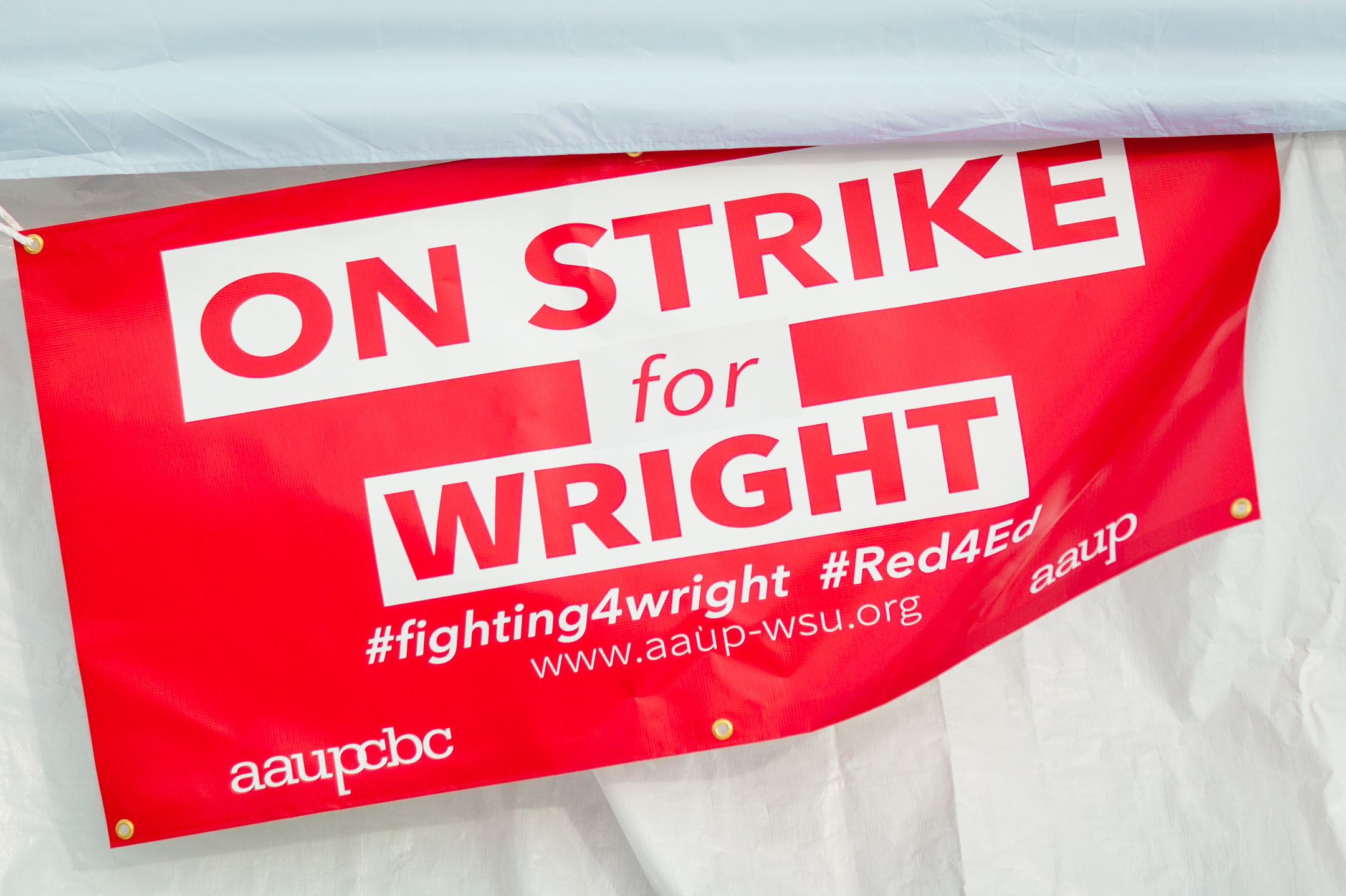
Faculty walk out, banner | Photograph by Soham Parikh | The Wright State Guardian
Following a strike that fostered months of distrust and anger on all sides, Wright State University administration said they’re taking a series of steps to rebuild trust within the campus community.
“I hesitate to use the word heal,” said Dr. Susan Edwards, the university’s provost. “I think what we really need to do is reconnect and re-engage with one another. Us and them is not the way to rebuild a relationship together.”
But interviews with dozens of students, faculty, staff, and administrators said trust continues to be an issue, some six-months after the three-week strike ended.
“You know when you have a strike like that there is division, and the things that occurred during that strike, it’s going to take time to build trust back. It doesn’t happen overnight,” said Representative Rick Perales, whose 73rd Ohio House district includes Wright State.
Wright State administrators have begun a number of initiatives;
- Dr. Cheryl Schrader, university president, said she’s organizing brown bag lunches with small groups of faculty from around the university. “I think it’s a great way to hear from faculty without a dean in between,” she said.
- Edwards plans to meet with faculty, staff, and students to hear their concerns calling it a ‘stump the chumps’ session where people can ask her anything.
- The university will host small group sessions with faculty, staff and administrators to build relationships and improve dialogue.
- The university’s The Longest Table event will focus on how to promote the positive aspects of Wright State.
After going without a contract for two years, the American Association of University Professors Wright State chapter (AAUP-WSU) and administration negotiated, went through fact-finding and exchanged contract offers. When the sides couldn’t agree on a new deal, the board of trustees, on Jan. 4, implemented a contract. The union responded by going on strike for 20 days.
“We have a new contract, we have a lot of people in new positions and it’s time to start fresh,” said Dr. Noeleen McIlvenna, president for the Wright State chapter of the American Association of University Professors.
The task of rebuilding trust and communication lay against the backdrop of declining enrollment during the fall semester that started last week.
Wright State expects enrollment to drop by 16 percent year-over-year decline in enrollment that could cost the university $18 million in lost tuition.
Another part of the university’s communication plan involves showing employees how they can “play a role in recruiting Wright State students,” according to information Wright State provided.
State Representative Fred Strahorn, the House Minority Leader who serves on the Higher Education Committee, believes focusing on what makes Wright State successful will help in bringing unity to the campus community.
“You need to look for common ground, focus on success stories. Nothing brings people together like winning. Where can you be successful? At the end of the day, you both have the same goal but maybe a different path to get to it. There might be different pressures on one than the other, but focusing on where the success can happen can be a good catalyst,” said Strahorn.
Daniel Palmer, former President of the Student Government Association, encouraged everyone to come together for the good of the university.
Palmer encouraged all sides to overcome “our past and looking for the best in people and trying to move forward. You need to love where you work and go to school. Division is not going to get us any further.”
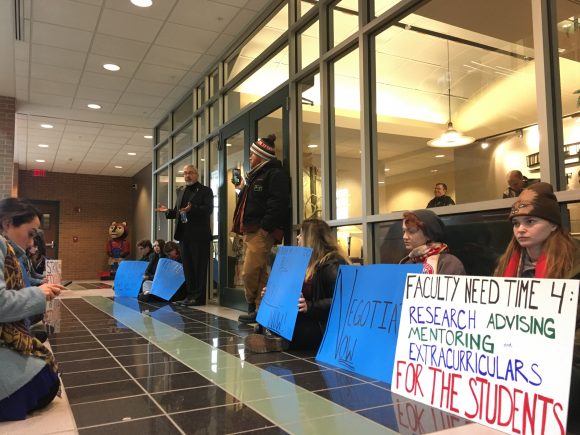
‘We have a long way to go’
Across campus, many see the decrease in tension since the end of the strike in February of 2019, but unanimously members of the campus community say we have a long way to go to trusting one another again.
“I welcome anything and any initiative they [administration] try, anything can be improved from last year,” said McIlvenna.
According to both President Schrader and Provost Edwards, the focus needs to be reshifted to the common core of why everyone works at Wright State.
“We’ve lost the art of communication at the conversational level, how do we rebuild that conversation on campus and really see each other as individuals?” said Provost Edwards. “We are all here for the same reason, we have more commonalities than we have differences and how do we reconnect those?”
Terms such as labor peace are being reiterated by members of both the AAUP-WSU and Wright State administration.
“Higher education is in a real challenging time, what happened here is not an anomaly, the fact that we have labor peace through 2023, no one else can say that,” said Schrader.
With enrollment in question as the fall semester numbers start to become more clear, the students on campus are beginning to move forward after months of division and frustration but not without impacting the community.
Parents like Chris Swolls were unsure of Wright State’s stability. When it came time for her oldest son, Blake, to look at schools, Wright State wasn’t on the list.
Blake had enrolled in College Credit Plus early in high school, which allows students to take high school and college classes simultaneously. An outstanding student with excellent grades, Blake was set to graduate from Franklin High School and Sinclair Community College and was planning on studying mechanical engineering.
Swolls’ son considered the University of Dayton, Purdue University, and the Ohio State University, among many others.
“When it came to hearing about the teacher strike and all the things that were going on it seemed like too much of a risk,” said Swolls. “When it came to all the things that went on at Wright State I never even contacted them.”
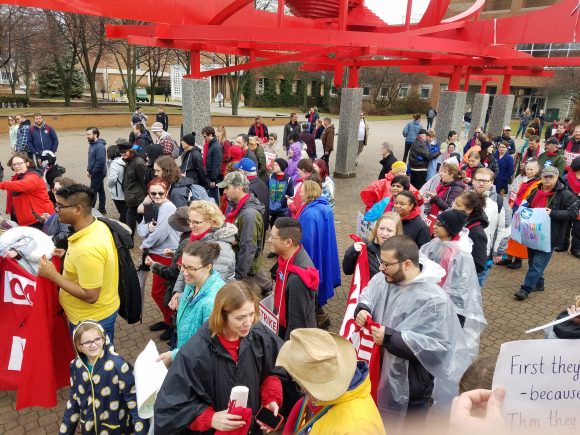
Wright State a right choice?
During the duration of the strike, students began to question if they should leave the university.
The overarching theme from students interviewed: they stayed because they know Wright State was where they wanted to be.
“I was actively thinking about and talking about transferring to [the] University of Cincinnati,” said Tyler Boes, Wright State student. “I was trying to figure out if it would set me behind, and how much more it would cost. The thing that kept me here at Wright State was my fraternity. It would have broken my heart to leave them, and as president I couldn’t leave them in a bind like that. But transferring was definitely something I considered.”
In addition to rebuilding trust, students worry about the long-term impact of the strike.
“We were definitely worried, a strike right at the entrance as your coming into the university probably isn’t the best look for people coming in,” said admissions ambassador Andrew Batista.
Sophomore Damian Langstaff noted the potential long-term impact.
“When you really look at enrollment, it’s not like it’s just ‘okay we have less people,’ it’s like it will affect the decisions that Wright State is able to make,” said Langstaff. “The students who excelled academically, who said okay Wright State is right for me, based on this situation, they might take their valedictorian self, their 4.0 self, to another school. Wright state might feel that.”
Gina Keucher, program director for Student Involvement and Leadership, had the same concerns.
“As the strike went on, and you saw the news, and families posting on Facebook [writing], ‘I’m not going to send my kid to Wright State,’ then you start to think that’s going to affect enrollment, and what is that going to mean? Does that mean more staff lose their jobs?” Keucher said.
In August, Walt Branson, vice president for Finance and Operations and Chief Business Officer, presented a budget for the fiscal year 2019-2020 to the Board of Trustees.
In it, he projected a 16 percent year-over-year decline in enrollment that could cost university $18 million in lost tuition. The projection shows 13,380 students starting this fall compared to 15,558 last year.
The trust factor may very well be the biggest hill to climb.
Several people interviewed spoke of the lingering damage that continues.
“There is absolutely a lack of trust between students, professors, and administrators,” said Jackson Cornwell, a junior philosophy and political science student. ” I don’t think the students trust either side fully, I want to believe the [administration] and professors are trying to repair those bridges but it’ll be a long way until we’re back to where we were.”
Amanda Watkins, associate director of the Veteran Military Center, echoes Cornwell.
“There is a little lack of trust from our students if it could happen again. There is a divide between faculty and staff members and that will be an ongoing effort,” said Watkins.
Randy Gardner, the chancellor of higher education for the state of Ohio, sees a path forward.
“Find areas to agree, areas to collaborate,” said Gardner. “Even if there are continuing differences try to set those aside by accentuating the importance of coming together because the future of administrators, faculty, students, parents of the community, are all impacted by minimizing our differences and accentuating the positives. How well we understand the importance of coming together is really going to say a lot about the future.”
Collaboration is on the minds of those in upper administration as well as those in the faculty union. Since the strike ended on Feb. 10, tensions are beginning to subside.
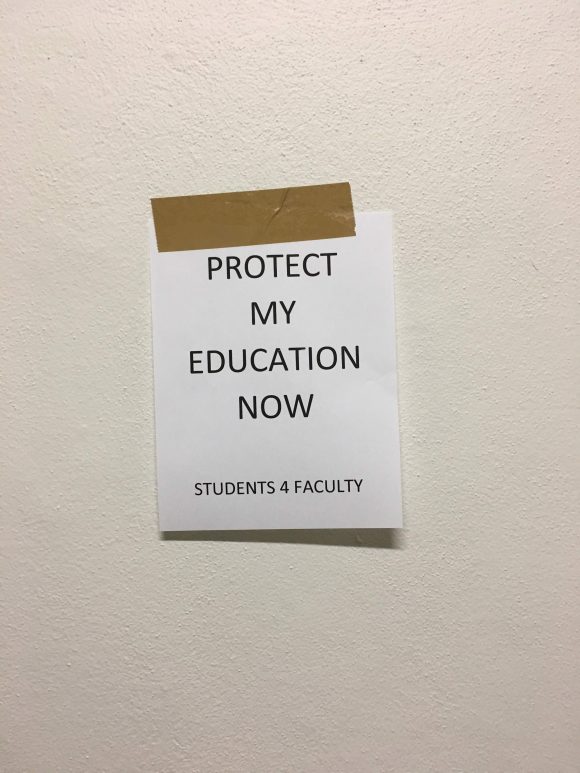
The Aftermath of a Higher Education Strike
Students have begun to mentally move forward as they begin a new semester and new academic year.
“It’s like when mom and dad are fighting, they try to pit one kid against the other parent,” said Travis Terracino, a senior, who was involved in the Students for Faculty group. “And when it’s finally over, you’re just like thank god I can go outside and play again.”
Students for Faculty members say now, even months later, resentment lingers.
“A good portion of the students that I kept in contact with from the strike, have moved on,” said Kayvan Ehteshmi, a member of Students for Faculty. “But some are still angry, some people still want the president and other (administrators) to resign due to how they conducted themselves during the strike.”
Faculty came back to stress and tension in and out of the classroom.
“When I came back and saw my chair, the first thing I said to her was I’m really disappointed in some of the decisions you made,” said Amelia Hubbard, an anthropology professor in the sociology and anthropology department. “I think they have really negative consequences on our majors and I wish once you saw they were not working you would have changed your strategy. And then I basically gave her a hug and said ‘how are you doing?’”
Jacob Brinkerhoff, a senior who graduated in May, said he noticed a change in atmosphere when the strike ended. Brinkeroff served as a resident assistant in student housing and worked in the President’s Office, and described the energy being sucked from campus. He noticed students not engaging in campus activities and in the classroom as much.
“It just drained a lot,” said Brinkerhoff, referring to morale, emotions and motivation in and out of the classroom.
In the aftermath of the strike, several people labeled the work stoppage a failure on all sides. Students felt caught in the middle of dispute that didn’t involve them.
Dr. Seth Gordon, director of the Veteran and Military Center, sees a failure in leadership.
“The fact that a strike happened is an incredible failure of the shared governance process here at Wright State. It is very easy to point the finger, but that’s not how leadership works.
The students and those of us who are not those people or don’t have the influence, as senior leadership faculty and administration, just watched you try to destroy the campus. So what are we going to do to repair?” Gordon said.
According to President Schrader, the open dialogue is meant to build a foundation so a strike can be avoided in the future. There were many key events that lead up to the strike.

A strike that was years in the making
While the strike happened in 2019, the impetus for the work stoppage actually began years earlier.
Under the administration of former President David Hopkins, Wright State made a number of blunders that cost the university millions.
In investigations by The Dayton Daily News, the university’s property and buildings acquisitions, paid settlements, and other losses contributed to the draining $130 million in reserves. The university pulled out of hosting a 2016 presidential debate after spending at least $4.3 million to host it. The university cited security and cost issues and now faces several lawsuits as a result of its decision. In 2018, Wright State agreed to pay $1 million to settle an HB-1 visa case in which the federal government alleged fraud.
And that’s not all.
Wright State spent $850,000 on a logo that wasn’t even used, the school scrapped it before publication. Wright State also paid nearly $2 million more to settle a U.S. Department of Education complaint when the school couldn’t show students who received financial aid attended classes. An audit showed contract underbilling and cost overruns cost the university $4 million.
The damage was so bad, trustees cut $30.8 million from the fiscal 2017 budget and another $53 million from the fiscal 2018 budget. Resulting in the cuts to dozens of jobs and even more left vacant.
“We are trying to help you save this university,” said Trustee Bruce Langos in an April 2018 budget meeting. “When I see that kind of other-spending going on, it’s frivolous to be honest with you. It is ridiculous for us to even be sitting here with you right now, if you’re not willing to help yourself.”
In the midst of all of this, in 2017, the faculty union contract expired. The AAUP-WSU, with 561 members, came to the bargaining table to find the university hired an outside attorney, setting the tone for the negotiations.
“The relationship has eroded between administration and faculty,” said former AAUP-WSU President, Dr. Martin Kich. “We always had a collegial relationship prior to years ago.”
Over the next two years, the union and administration met multiple times to hammer out a deal, but couldn’t.
The parties met twice in the fall of 2018.
“At the conclusion of the second meeting, the administration’s chief negotiator simply stated that these meetings were a waste of time and he was unwilling to participate in future meetings.”
said Dr. Tom Rooney.
Rooney, a faculty member who teaches biological sciences, served on the union’s negotiating committee.
The parties agreed to fact finding, the process in which an independent third party reviews the unresolved articles in the contract from both sides.
The factfinder issued a report that agreed with several university proposals, including greater layoff flexibility, no pay raises during the life of the contract, increase furlough days, and changes in overall health coverage.
In November of 2018, the board of trustees approved the report. The union overwhelmingly rejected it by a vote of 467-12.
Negotiations again were at a standstill.
On Jan. 4, the Wright State Board of Trustees voted to impose what it termed its best, final contract offer. The union quickly rejected the deal and, on Jan. 14, filed with the Ohio State Employees Relations Board an intent to strike on Jan. 22.
On Jan. 18, the union sent a letter to the administration and asked them to meet. Rooney said Wright State negotiators never responded.
That set the stage for a 20-day strike that would become the longest in Ohio higher education history.

Preparing for the Worst
Faculty reiterated they did not want to strike, but were prepared.
“I just told myself, I’ve been poor before,” said Dr. Noeleen McIlvenna, current union president and history professor, who was on the executive committee during the strike. “I grew up pretty poor. I can live on less than I live on because I have. There are certain bigger principles here, and what’s it all for if you can’t stand up for them? Yes, there’s a cost.”
The walkout was doubly painful for McIlvenna because her husband, Dr. Lance Greene, also went on strike.
Like McIlvenna and Greene, faculty members faced the choice of no pay, no insurance, and no benefits during their time on strike. Wright State, in a press release, said about 270 union members taught during the strike. The union, in its own release, said about 300 faculty went on strike. With 561 members in the union, the numbers nearly match.
“I’m a single-income household, so all of the benefits and health care come from me and my job. And they were all suspended,” said Dr. Liam Anderson, a political science professor. “It’s kind of scary not knowing when the end point is…. if something had happened to my family during that period we would have had to pay for medical expenses out of pocket.”
‘It was a scary time’
Students of the university had known bits and pieces of information but no one knew what to expect before the faculty walk-out happened.
The night before the Jan. 22 walkout, Wright State students received email and notification alerts that the campus would remain open despite the anticipated strike. Wright State’s official social media began to promote a “Go to Class” campaign and emails informed students attendance would be taken in classrooms.
Publicly, Wright State ensured it was ready with instructors and adjuncts to cover courses where professors walked out. But some students arrived for class with no faculty and quickly grew upset.
“I drive nearly 45 minutes for my classes and two of the three were affected by the strike,” said Rachel Karnehm, a sophomore mechanical engineering student. “I was walking into class, and my professors were standing outside of the classroom not teaching and I was really frustrated and really disappointed. Like this has gone too far, this was ridiculous. I’m sitting in a classroom where you’re supposed to be teaching me and you’re not. You’re outside standing, screaming at the top of your lungs about something that doesn’t even involve me.”
Students weren’t the only ones frustrated. Dawne Dewey said library staff, charged with offering alternative course work during the strike, felt “punished.”
“We were told at the beginning of the strike no vacations, you’re not allowed to take any time off, if you have a medical issue you have to get a note from your doctor proving you were at the doctor,” said Dewey, the Head of Special Collections and Archives. “So the staff felt like we were being punished, we’re all adults and professional people who have invested a lot in the university and now all of a sudden were being treated like a school kid who had to get a note. That was hard to swallow. It was all hands on deck and the staff had to keep the university open if the faculty went out. We’ve already lost a lot of staff through the financial crisis and yet we were being asked to hold down the fort and cover classes.”
And then divisions started.
Students for Faculty formed to support their professors. The group arranged marches from the middle of campus to the entrance to join striking faculty, chanting and holding signs. Outside the Office of the President, two separate sit ins were staged. One lasted more than 24 hours.
Students used social media to lash out. One twitter exchange resulted in a student calling a member of student government “a liar and a coward.”
The rhetoric escalated.
According to a Wright State University police report, a former student called RaiderConnect on Feb. 7 and threatened several times to kill the administrator responsible for student enrollment services. The report said the caller was angry about “the strike and classes being held in limbo.” The caller filled out a criminal trespass report but no charges were filed.
Students painted the picture of classes in turmoil. One student sat in class with headphones on while a substitute tried to lecture. Students were confused whether they needed to sign attendance sheets during the strike. Others scrawled notes on blackboards with succinct messages including “thanks for nothing.” Another wrote a longer note that said: “Two classes in a row, we showed up, and no one from the university showed up to take attendance. Thank you for ‘caring’ for your students.”
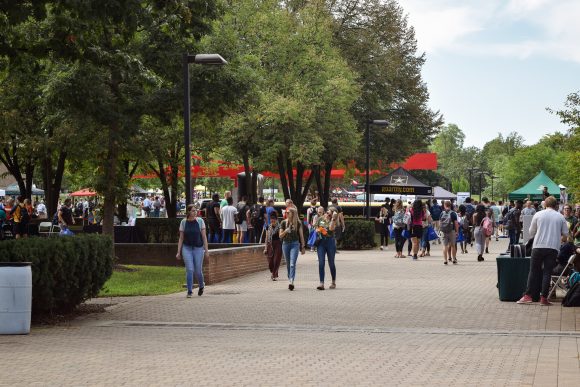
‘A fresh start’
Months later, the rhetoric is adjusting of one from ‘they and us’ to ‘together’.
“In my mind, one of the best ways to move forward is together, creating the future for this institution,” said Schrader.
With a shift toward restoring Wright State’s community to being whole and undivided by politics, the two parties are beginning their work to rebuild trust.
“We are all the same, we are all here for the same mission,” said Edwards. “Working together is the way forward. There is no you, us and them. I always come back to my core mission, students. But we all have to communicate and that takes work.”
President Schrader praised the staff for its professionalism during a tough time.
“The staff that worked through the strike were tremendous,” Schrader said. “There’s no other way to describe it. This was a burden for everyone. It was a new territory that there was no playbook for. We were astounded by the staff of the support and investment, what lengths people went to make sure the students got what they needed.”
With the semester now in week two, the community has begun to come together again in more ways than one. Between Fall Fest and the anticipation for Homecoming Week, students are rebuilding their divide. The administration has begun meeting with faculty to begin their open dialogue.
These are just steps in the process of ‘reconnecting and re-engaging’ a community.
